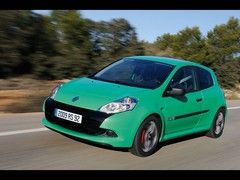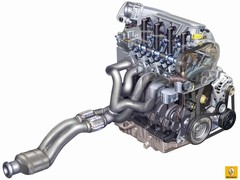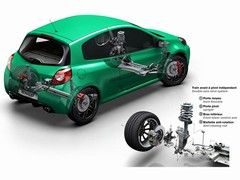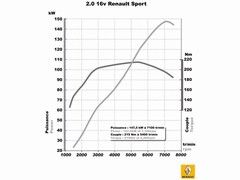Clio Renaultsport 200
A revamped nose is only half the story. Chris Rosamond discovers the new 200 Cup runneth-over with the right stuff
When Renault took the wraps off its lightly restyled Clio Renaultsport range at the Geneva show a couple of months back, we didn’t get too excited.
Our PH ‘tourists’ briefly clocked the new family nose job, dutifully noted a 3hp power boost that explained the name change from Clio Renaultsport 197 to Clio Renaultsport 200, and then drifted off to dribble over the assorted supercars. With so much glamourous metal about, it’s a miracle the newcomer from Renault made it into our show coverage at all but, out of deference to PistonHead’s army of Renaultsport enthusiasts, we probably should have paid more attention!
Fortunately, a last minute invitation from Renault to join the recent launch of the 200 in Portugal has provided an opportunity to set the record straight.
Actually Renault launched two ‘sporty’ Clios in Portugal, so we’re bound to mention there’s a new Clio GT model coming to a showroom near you. The Clio GT is blessed with pleasingly sporty styling fripperies such as drilled aluminium pedal covers, twin exhaust tailpipes and a lippy little spoiler, but it’s also got a 128hp 1.6 petrol engine that feels gutless to the point of mild embarrassment, so you probably won’t be hearing much more about it here on PH.
Except, I suppose, we should mention the GT does have potential to gently tantalise an enthusiastic driver’s tastebuds, thanks to a mildly uprated chassis that clings-on with unexpected tenacity in fast corners, and to steering which is a little on the light side but has all the directness and accuracy of… well, a decently-sorted Renault.
So if the GT is good for anything, it’s to prove that the latest Clio chassis can be made to handle like a good ‘un, although rave reviews already afforded to the outgoing 197 Cup have made that point well enough.
Having sampled the 197 Cup’s successor for a dozen laps of Portugal’s neat little Braga circuit, we can say the new Clio Renaultsport 200 Cup rams the point home in far more emphatic style than we had a right to expect from a car that appeared to be little more than a mid-life facelift.
So much so, we’re inclined to share a gathering consensus that few hot superminis, if any, have been made to handle trackday forays with such aplomb. We’ll find out soon enough if the same can be said of the new Clio 200 Cup chassis on the UK’s less than perfect roads, but for the moment the car seems to be - at the very least - the trackday tool par excellence in its class.
The key to the new model’s increased appetite for circuit work lies in the strangely disparate nature of demand for Renaultsport models in different markets.
We Brits are a hardcore lot (hooray!) who want our Renaultsport chassis to really handle. The French, on the other hand, are a bunch of softies (hiss!) who will apparently opt for a bit more comfort every time they’re given half a chance. Thus Renaultsport tends to split its hot hatch models into two lines, offering both a standard Sport chassis and a feistier Cup version beloved by the Brits. Vive le difference, as we say in France.
This time around, that difference has been amplified as Renaultsport appears to have given up trying to convert the softies, instead pandering to them by relaxing the Sport chassis’s damping by 15 percent against the 197. The good news is they’ve taken that nominal 15 percent of unwanted damper stiffness and dialled it straight back into the 200 Cup chassis, so everyone’s a winner.
The 200 Cup chassis also benefits from front and rear springs that are 30 percent stiffer than the standard Sport, and the car rides 7mm closer to the ground. The other key set-up difference between the Cup and Sport 200s is electrically assisted steering that’s 7.5 percent quicker on the Cup chassis.
The Cup also sheds nearly 40kgs through a ‘de-contenting’ process that eliminates standard-fit ‘luxuries’ from the Sport model such as curtain airbags, reach adjustable steering, split-fold rear seat and body-colour side mouldings. (Although if you want luxury and performance, you can specify the Cup chassis set-up as a £400 cost option on the standard Sport model.) Both versions get the revised 2.0 litre engine with a new cylinder head and tweaked mapping, which sees power rise by 3hp to the magic 200hp at 7,100rpm, although the more significant effect is a 20 percent rise in torque in the lower half of the rev range. The gear ratios have also been widened, with lower ratios for 1st, 2nd and 3rd giving better low-speed punch, while 6th has been lengthened for quieter motorway cruising.
Stephen Marvin, a Brit who is the technical director at Renault Sport Technologies, was on hand at Braga to explain the thinking behind the 200 Cup revisions.
“We’re trying to really differentiate the two chassis types a little more. We’ve added more comfort to the Sport chassis through the damping, mainly because that’s what certain markets demand, notably in France,’ he says. ‘On the Cup chassis we went a bit more radical and have adjusted the damping and steering, as well as making the car lighter.
‘We’re also using dual-effect dampers – instead of using one set of damper valves you’ve got two sets. That means you’re working the fluid in the dampers less, so there’s less chance of cavitation or the dampers going off. The performance will keep up even when you’re giving the car a really hard work out.’
The Clio 200, like the 197 comes with an independent steering axis suspension set-up that Renaultsport has been using on the Megane for a while. Like the much heralded set-up Ford introduced recently on the Focus RS, it is designed to allow the steering axis to operate totally independently of the damping, significantly reducing torque-steer under hard acceleration.
‘We were a bit miffed when Ford came up with the name Revo-Knuckle for the suspension on the Focus RS, as we introduced our system on the Megane RS five years ago but without a catchy name so fewer people have heard about it,’ jokes Steve. In the 200, the set-up has been improved over the 197 with new alloy hub carriers and rose-jointed bushes to replace the top bearings.
These revisions have reduced the unsprung mass by 1kg at each corner, with lower rotating mass improving ride comfort and sharpening turn-in.
Renault claims the 200 Cup has the best power to weight ratio in its class at 166hp per tonne, but that hasn’t deflected earlier criticism in the PH forums that the Clio is on the lardy side at 1204kgs.
We put this to Steve, and he didn’t dodge the issue: ‘All the cars in this segment have got heavier, but if you want a car that achieves 5 stars in EuroNCAP then you have to put up with it,’ he told us. ‘That said, when we change generations there will be a requirement to lose some weight, but there’s a limit to what you can achieve during mid-life revisions.’
He continued: ‘I drove an original Clio Williams recently, and while it was great fun to have 150bhp in a 900kgs car, it didn’t feel very stiff by today’s standards and the refinement isn’t there either. You wouldn’t think twice about a doing a long journey in the 200, but you might feel differently about doing the same in the Williams.’
The only other significant criticism that has been aimed at the 197 Cup was the notion that the steering was lacking in feel.
‘We switched to electric power steering in the 197 for the fuel saving benefit and also to improve reliability by eliminating the chance of fluid leaks,’ says Steve. ‘We think the steering is now very precise with the improvements we’ve made for the 200, but we haven’t gone out of our way to make it heavier for the sake of it.’
‘People often confuse ‘feel’ with weight, or with steering corruption, meaning things like torque-steer and also some elements of bump-effect steering. What drivers are generally after is steering that you can feel weighting up in a corner with speed, and then lighten as you start to lose grip. With the 200 Cup we definitely deliver that.’
Once out on the track at Braga, it’s time to put the revisions to the test. First time around is a warm-up behind a safety car, and an opportunity to be immediately impressed by the slick yet positive change of the six-speed gearbox; the lever always seemingly in the right plane for the next ratio, and never a hint of notchiness or baulking during snatched gear changes. In fact the shift embodies an easy, confidence-building familiarity that shines through in nearly every aspect of the Clio 200’s character on the track, and helps make it such a hoot to drive.
As speeds increase for our handful of ‘hot’ laps on a dry track, the combination of super-grippy Continental Contact3 tyres (a bespoke compound for the Clio 200), roll-resistant suspension and supremely accurate steering makes the Cup chassis an utter delight.
The steering is very light, but it does deliver truly incisive turn-in, and the trick front suspension all but eliminates any sense of torque-steer. When the front end does start to drift wide - whether through carrying too much speed into a corner or woefully irresponsible application of power on the exit – the wheel never leaves you feel anything less than connected to what’s happening on the ground.
The brakes, too, are utterly gob-smacking and offer performance on a par with far more exotic machinery. Independent testing in Germany has proved the point, with the 197 Cup matching the Porsche Cayman’s impressive 35 metre 100km/h to Zero distance over 10 consecutive stops.
On the track, the brakes are so intoxicatingly strong there’s an inevitable tendancy to try outbrake yourself, but plunging headlong into a tightening apex with braking still to be done reveals the most rewarding aspect of the 200 Cup’s handling. The chassis is simply so ‘adjustable’ on the brakes and throttle that even the most cack-handed of pilotes will find themselves nonchalantly balancing the car on the edge of adhesion as they hurtle through the trackday twisties – and if they’re anything like this humble scribe, feeling utterly heroic while they’re at it!
If you’re looking to spend £15,570 on having a ball, but also need a car that offers genuine practicality and sufficient refinement for everyday use, you won’t be disappointed with the Clio Renaultsport 200 Cup. However Renault expects most 200 customers in the UK to splash out an extra grand for the more luxuriously-equipped Sport version, and then top it off with the £400 Cup chassis option. Either way, you’ll be on to a winner.
Gassing Station | General Gassing | Top of Page | What's New | My Stuff








